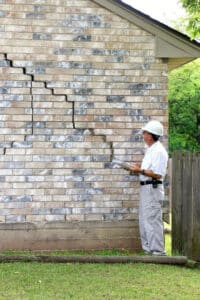A good foundation is vital for a healthy home. However, your home’s foundation may shift or crack over time. While these changes are usually subtle at first, they can quickly spiral out of control and put the structural integrity of your home at risk. You put a lot of money into your home, and you don’t want to have to pay for expensive repairs down the road. Therefore, if you’re going to keep your home in tip-top shape while saving time and money, then you should check out this quick guide on how to properly perform a foundation evaluation.
Scan Floors and Ceilings
Are your floors and ceilings level? Do you notice any strange dips or weird angles? A strong foundation is supposed to keep your house level, so if your walls and ceilings seem crooked, that could indicate a severe problem with your foundation. You should also ensure that your floors and ceilings aren’t bowing or sagging. While bowing and warping are sometimes only a result of water damage, you must still note them while performing a foundation evaluation.
Take Note of Any Cracks
A foundation issue will cause the weight in your home to shift in awkward and unnatural ways. In turn, this may cause cracks to form in your ceilings and walls. Cracks occasionally form after years of wear and tear, but you should be especially concerned about any growing gaps or cracks that are not completely vertical. For a more effective foundation evaluation, you should remove large paintings from your walls and look behind big appliances so that you don’t miss any hidden cracks.
Find the Source of Mold and Mustiness
Your foundation should keep water out of your home, but water can easily seep through a crack. This will lead to mold, mildew, and mustiness. If you notice odd spots on your walls and ceilings or strange odors, then you should follow them to their source. Mold and water damage on the second floor or attic may have something to do with a damaged roof, but if you notice water damage on the first floor or in the basement, then you might have a crack somewhere in your foundation.
Circle the Perimeter of Your Home
As you perform your foundation evaluation, you should go outside and walk around the perimeter of your home while scanning the foundation and the ground around it. Large cracks are an obvious sign of foundation damage, but other evidence may be more subtle. For example, dips in the ground near your foundation may indicate that water is pooling up around a certain point. Dips and unevenness can also be a sign that the weight of your home has shifted.
Open and Close All Windows and Doors
When your foundation is in good shape, all of your windows and doorways should be straight and level. Consequently, your doors and windows should be easy to close. While conducting your foundation evaluation, it’s a good idea to open and close all windows and doors. Take note of any friction or awkwardness. Sometimes, a window or door needs a little lubrication, but you should be concerned if the problem persists or shows up in multiple doors or windows.
Have You Found Something Wrong With Your Foundation?
A strong foundation is the backbone of your home. Thus, if you notice any problems while performing a foundation evaluation, you should immediately call a reputable professional. They’ll send a skilled team out to check out your home, diagnose the problem, and help you find the best solution. Dealing with a damaged foundation may seem daunting, but you don’t have to face it alone. By reaching out to the right crew to help with your foundation, you can stop the problem before it gets worse and save a lot of time and money in the process.